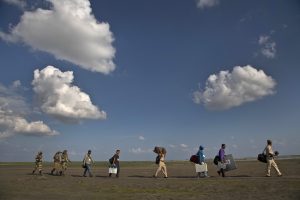The Bharatiya Janata Party (BJP)-led National Democratic Alliance (NDA) is likely to win the largest number of seats in the forthcoming general elections in India’s frontier region of the Northeast, similar to the results of the last general election five years ago.
India’s Northeast comprises the eight border states of Arunachal Pradesh, Assam, Manipur, Meghalaya, Mizoram, Nagaland, Sikkim, and Tripura. The region accounts for 25 seats in the 543 seat-Lok Sabha, the lower house of the Indian Parliament. States in the region will vote on April 19 and 26 and May 7.
In the 2019 general election, the NDA won 18 seats in the Northeast, including 14 that the BJP aloe won from the states of Assam, Arunachal Pradesh, Tripura and Manipur.
Assam Chief Minister Himanta Biswa Sarma of the BJP, who is convener of the North East Democratic Alliance, a BJP-led bloc in the Northeast, claims that the NDA would win 22 seats across the region in the upcoming general elections.
Discussions with political functionaries from different parties revealed that the BJP and its allies have an edge in 20 constituencies. The contest in the remaining five is expected to be tough.
In Assam, which has the highest number of seats (14) among all the northeastern states, the ruling BJP has fielded candidates in 11 constituencies and its allies – the Asom Gana Parishad (AGP) and the United People’s Party Liberal (UPPL) – will contest from the remaining three. In 2019, the BJP won 9 seats from Assam. The UPPL and AGP failed to secure victories from their allocated constituencies.
The delimitation of electoral constituencies in Assam, which was pending for the past two decades and completed in December 2022, is expected to benefit the NDA. BJP leaders themselves have admitted that the delimitation exercise has brightened the party’s electoral prospects.
Across the northeastern states, the opposition is weak and divided. In Assam, the United Opposition Forum Assam (UOFA), a 16-party alliance led by the Congress, is riven with differences over the sharing of seats and has triggered disenchantment in the coalition. A senior functionary of the Aam Aadmi Party (AAP), which is part of the alliance, pointed out that the “Congress gave only the Dibrugarh seat to the Assam Jatiya Parishad (AJP) and kept the remaining 13 seats to itself. So, there is no united opposition to the NDA in Assam.”
In addition, if some Congress functionaries are to be believed, the party has been jolted by a financial crisis resulting in less funds for the expenditure of contesting candidates. The BJP and its allies, on the other hand, are aggressively campaigning and highlighting the numerous welfare schemes that were rolled out in Assam by its government over the past few years.
Not surprisingly, issues raised by the opposition parties such as the implementation of the Citizenship Amendment Act 2019 that had triggered a ferocious agitation in the region five years ago and the controversy over electoral bonds are unlikely to have a decisive impact on the minds of the voters.
In Assam, the NDA will face a stiff contest from the Congress in Nagaon and Jorhat constituencies and from the All India United Democratic Front (AIUDF) in the Muslim-dominated Karimganj and Dhubri. There is a high possibility of the Congress losing Barpeta to the BJP’s ally, the AGP, after delimitation as a large chunk of areas inhabited by Bengal-origin Muslims have now been attached to the contiguous Dhubri constituency.
A huge disadvantage that the opposition Congress faces in the Northeast has been its inability to win any state assembly elections for the past several years. The BJP and its allies have governments in six out of the eight states in the region. In the hill states of the frontier region, the electorate is inclined to vote for the ruling party.
Issues that are important to voters vary from state to state. In Meghalaya, implementation of the Inner Line Policy (ILP) prevalent in the other hill states, the Citizenship Amendment Act 2019, and resolution of the border dispute with Assam are key issues. Termination of the Free Movement Regime (FMR) with Myanmar is a major issue in Nagaland and Mizoram.
In Mizoram and Sikkim, which have non-BJP governments, the party in power is expected to do well. Mizoram’s single seat in Parliament is likely to go to the ruling Zoram People’s Movement (ZPM), which has announced that it would not ally either with the Congress or the BJP but would support any government at the center for the interests of the state.
In Sikkim, the BJP has snapped its alliance with the Sikkim Krantikari Morcha (SKM), which rules the state. Both parties have fielded candidates for the lone seat in the hill state, besides other parties. There is a high possibility of the SKM winning the seat and it is also likely that the party will adopt the ZPM’s policy of supporting any government at the center.
The electoral situation in Shillong in Meghalaya is unpredictable, especially after the emergence of the Voice of the People’s Party and the Regional Democratic Alliance, which is an alliance of two parties.
As for Manipur, a tough contest among the seven candidates is on the cards in Imphal valley (Inner Manipur), while the Naga People’s Front (NPF) has an edge over the other parties in Outer Manipur comprising the hill districts.
In neighboring Nagaland, which has a single seat, the BJP and NPF are constituents of the coalition government called the People’s Democratic Alliance. The NPF is expected to win the seat.
Arunachal Pradesh and Tripura – both BJP-ruled states – have two seats each. The BJP is expected to make a clean sweep in all these four constituencies. The two states will also vote in elections to the state assembly at the same time.

































